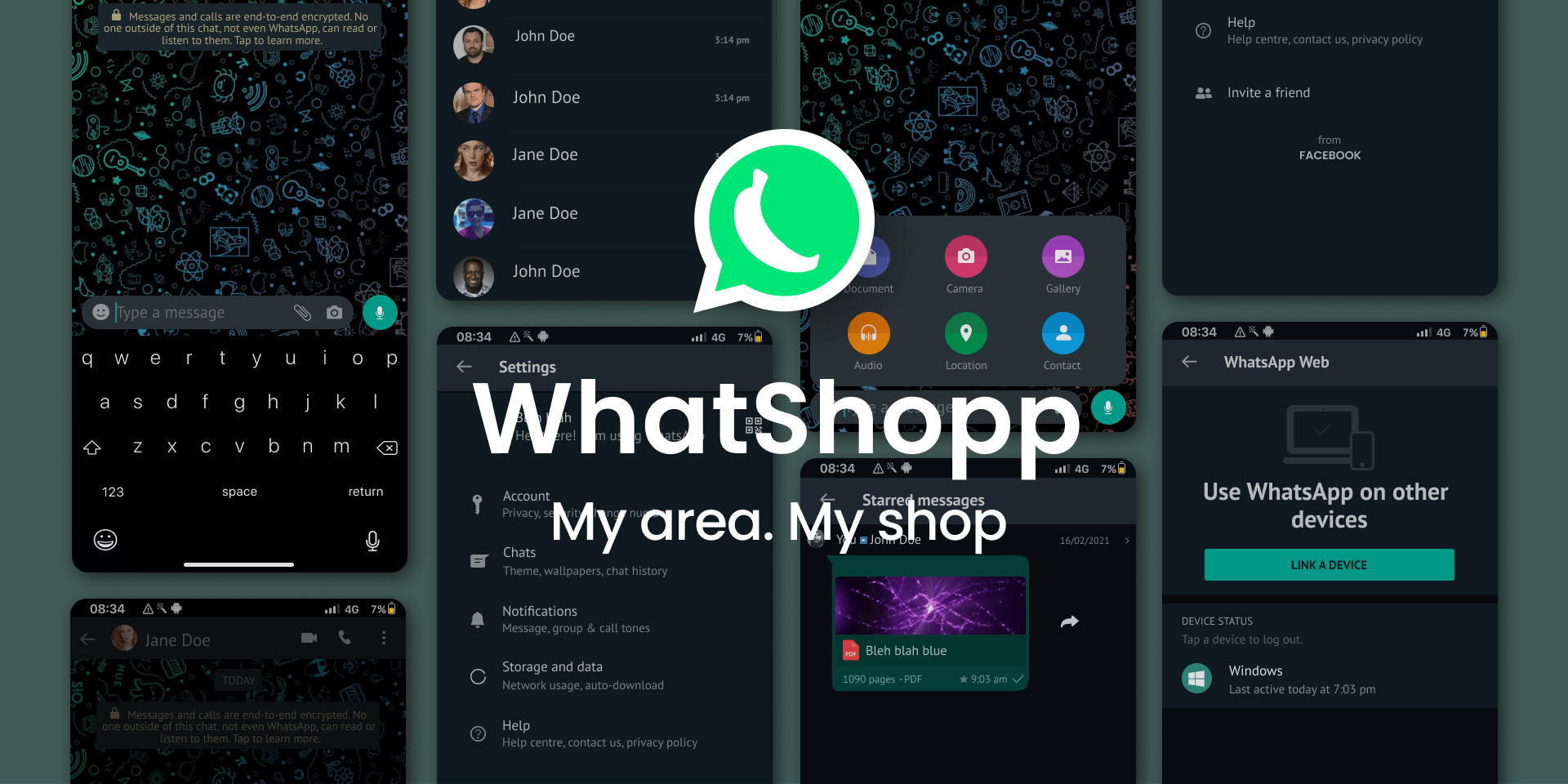Powering SMEs for ecommerce through WhatsApp
The Indian online grocery market is estimated to reach US$ 26.93billion in 2027 from US$ 3.95 billion in FY21, expanding at a CAGR of 33%.
Personally, I've been quite bothered by how much of this market is addressed by the tech giants like Amazon, Flipkart, BigBasket, Grofers (now BlinkIt) & other players. I've always enjoyed great relations & friendships with the local stores I used to rush down to buy everything from fruits & vegetables, to sweets, condiments & other items of everyday use. Hence the urge for a solution that would take the pioneer of this decade's communication & embed into it, a business solution, where the MSMEs win.
The Story
What started as a simple dream to work at the company who had given this as an internship problem statement, as I waited for a bus, across its massive HQ on Hosur Road, it's blazing logo shining disruptively against the silent night, led me down to a journey of 1 month, of finding the solution to find what would define a "e-commerce system, where everybody wins"
The Interviews
Supposing is good, but finding out is better.
The Mom Test, by Rob Fitzgerald, beautifully explains how you can get validation about your problem statement & product, without even talking about it.
I brushed up the book on a lazy Saturday morning, and then started talking with the waiters about their grocery shopping habits. From then, I went cafe-hopping across town speaking to restaurant managers, home makers & calling friends from all over the country to understand how they'd been consuming these goods.
From their mixed buying pattern, spread across somewhat 12 mobile applications & local interactions, I was able to draw the following conclusions
Where do small shops beat large stores
- Delivery radius - Large companies may not deliver in smaller village areas but a shop in village can deliver intra village
- Trust - People find it easier to trust a physical person in a shop whose grain they can see and gauge quality of and hold this person accountable if quality fails. Don’t have to trust unknown 3rd party for quality
- Communication- Local sellers speak local language (may or may not work to benefit) and hence it is easier to communicate the needs and understand the names of listed products (eg : Onion in english, Kaanda in Marathi, Pyaaz in hindi).
- Quality Assurance- Can hold a physical person you’ve met accountable for orders like grain, pulses and get it return/replaced fast as opposed to customer support and TATs in most large companies
- Small items- Small items like bread, egg, stationery etc. is where these
- Human touch- Feels nice to step out of house, talk to familiar faces at the pretext of still working to buy stuff. Also, these sellers have a friendly relationship with buyers.
- Customer contact saving- Local shops don’t have customer details stored so difficult to get in touch with later
- Minimum order- For delivery, this is a deal breaker
- Discoverability is based on how well-placed your shop in terms of geography
Where do large companies beat small stores
- Product discovery - Listed items are inventory-managed, kept in stock, categorized and easy-searched for easy discovery as opposed to shelves and shelves of unlisted products just in the mind of the seller.
- Product availability - Since inventory is managed customers know what is available and what is not so TAT is less. For SMEs, not having inventory managed and lack of customer’s knowledge of whether item is available or not causes the buyer to make multiple rounds for purchasing an item.
- Delivery - Most SMEs can’t afford extra person for delivery whilst companies can
- Ingress - Platforms can handle 100000+ customers at the same instant while local seller will queue them up and take lots of time to process sale
- Partial shopping- You get the best products shopped across multiple stores
- Amazing UI - navigate shopping options seamlessly
- High Storage capacity- Physical store takes up lot of space. Instead a godown can be optimized to just store products efficiently and deliver to buyers as orders arrive.
- Uni-lingual- Interacting with a machine so no issues of a language the machine can understand like English. Can’t exactly order, in broken English from an non-fluent seller
- Item packs- Offered on grofers where they package commonly required items together
After this, was an interesting phase where I went ahead & tried out all the existing solutions to experience & interact with the UI to understand design at the lowest level.
This led me to actually realize some decisions that the other market players had taken, much better & come up with my own design philosophy.
The Core Design Principles
For any strong vision to manifest, a powerful design should be at the core driving it.
After the conclusions from the user interviews & trying out the products myself, I went on to formulate some fundamental principles I felt should be reflected in the design of the application.
They were - Trust, Simplicity, Communication & Community
- Trust
- Trust is of paramount importance as quality of food is an important decision of health
People really prefer to have quality of grocery, vegetables, fruits verified so this is something that can’t be compromised - Frequency creates trust - People use WhatsApp very frequently. So they’re comfortable with the UI system. Also, they’re connected to people through this app so having purchases with acquainted sellers feels a lot more safer and faster
- People in tier 2, 3 cities trust local vendors who they’ve maintained friendship with as opposed to an online-platform they know nothing about, where money disappears from their accounts but they barely can use UI to track what’s happening and can’t even speak to someone for doubt.
- Human on the other end, speaking in a local language instead of chatbots, answering machine feels a lot more reassuring
- Payments should be seamless and of all kinds to introduce inclusivity of sellers.
Small sellers in tier 3 cities prefer COD - Option for payment after goods QA test- After quality of goods has been verified on delivery, payment should be made. Existing approach between local vendors and buyers. This beats the drawn out online QA failures, TAT for return/refund
- System of “khata-keeping” can be kept between seller and buyer as the relationship is between a per-shop basis. Concept of part payments over a course of time
- Trust is of paramount importance as quality of food is an important decision of health
- Simplicity
- Flow must be very simple so that items can be discovered easily, added to cart and paid for
- Language inclusion must be provided
- Too many offers, carousels, page-redirections will be very confusing - keep no. of screens involved to minimum
- Product discovery must be really easy -
- Powerful search
- Effective filters
- Powerful recommendation - To help plan orders
- Comparative pricing - since in local market we often see competitive rates being the deal breaker for vendors
- Setup reminders to refill stock based on shelf life
- Communication
- Human on the other end of a call instead of an answering machine or a chatbot.
Since small shops will have smaller customer base, they can provide the call and answer personalized service.
Result - very low TAT - The customer support and contact between the seller and buyer must be very seamless
- Call to seller must be available. Video call is also nice if seller is demoing a product
- WhatsApp chat will be easier to track orders with respect to a seller
- Better customer support in local language
- Personalized service since customer base is small so special requests can be made on whatsapp chats.
- Parcel delivery timings can be configured and post-order service can be super fast.
- Special requests can be made to seller to bargain, configure certain quantities
- Customized rates and offers as per the seller’s convenience.
- Customers are more in sync with the inventory of seller - so no returning empty handed from shop
- Incentives to stay connected - No minimum order, free delivery, discounts - the driving factor behind retention of customer
- Seller notifies latest store updates via whatsapp status - can be shown in story UI as a seperate category in whatsapp status.
So zero-cost advertisements. Anyways in non-urban community, trust and word-of-mouth always work a lot better
- Human on the other end of a call instead of an answering machine or a chatbot.
- Community
- A more, well-connected community with humans interacting with each other. More friendship and conversations brewing.
- Discoverability to all local businesses per geography, as opposed to being at the mercy of online marketplaces for the same.
- Inclusivity of sellers as opposed to an ad-manipulated environment like online product-level marketplaces Unlike them entry of new players is not difficult as there’s no paradox of lesser orders due to lesser ratings.
Here, trust is made on conversation with an actual person living probably 2 lanes away from you. - A more equity based approach to society since instead of coming on a common platform subject to restrictions, sellers can manage their own mini-online-marts subject to their own capacities and rules
This is the only difference between a bullying intermediary platform having full control over small business, full contact with the customer and a common equitable marketplace where customers are allotted to businesses based - Celebration of culture, community and region specific goods such as local foods, fashion and daily choices instead of americanization of marketplaces.
- The purpose is to also celebrate community and regional foods. By purchasing from local sellers, you build lifelong relationships of trust and friendship
- Promote a culture of home-cooked meals due to managed ingredients
The Design
The design for the entire project can be found in the Figma File below :

Also, here's a simple Kanban view of the most important design decisions I took, why I took them to align with my core design philosophy

The Conclusion
This was the 1st project where I handled all the pre-engineering part & it gave me a holistic sense of how a product is designed & why some decisions like this, can be game changers when catering to a large user base.
In a way, it shaped me to perceive products very differently since :)



